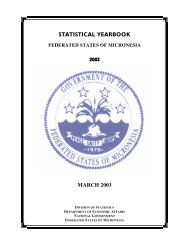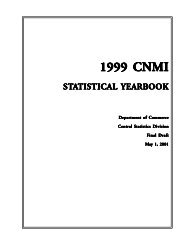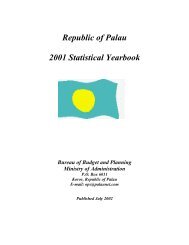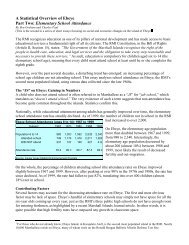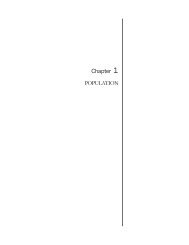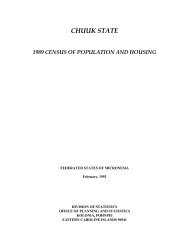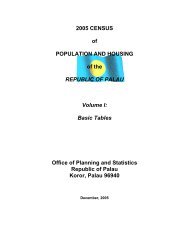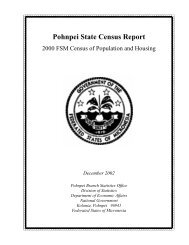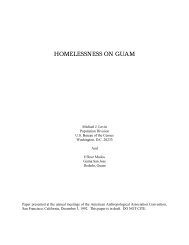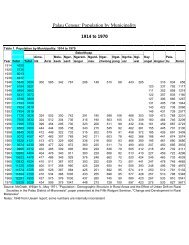Chuuk State Census Report - pacificweb.org
Chuuk State Census Report - pacificweb.org
Chuuk State Census Report - pacificweb.org
Create successful ePaper yourself
Turn your PDF publications into a flip-book with our unique Google optimized e-Paper software.
CHAPTER 12HOUSING CHARACTERISTICSIntroductionInformation on housing provides important insights to the level of development and often illuminating the interfacebetween a traditional cultural system and the modernization that has affected most of the Pacific during the latetwentieth century. The housing characteristics in <strong>Chuuk</strong> have been <strong>org</strong>anized in this chapter into four major sections;(1) general housing characteristics; (2) structural characteristics, (3) utilities, and (4) equipment. The 1980 censusresult was used to examine the change in housing in <strong>Chuuk</strong> <strong>State</strong> over time.The data presented in this chapter include the total and different types of housing units found in the 2000 <strong>Census</strong>. The2000 <strong>Census</strong> questionnaire contain a similar set of questions used in the 1994 <strong>Census</strong>, so the comparison of housingdata for these two years were consistent.Data DescriptionGeneral Housing CharacteristicsA housing unit is a house, apartment, group of rooms, or single room occupied as separate living quarters or, if vacant,intended for occupancy as separate living quarters. Separate living quarters are those in which the occupants live andeat apart from other persons in the building and which have direct access from outside the building or through acommon hall. Housing units built not for household occupancy but for groups of unrelated persons was defined asgroup quarter. Group quarters include institutionalized and non-institutionalized quarters such as prisons/local jails,hospitals, school/college dormitories, etc.The 2000 <strong>Chuuk</strong> <strong>State</strong> <strong>Census</strong> included both occupied and vacant housing units as part of the housing inventory.Recreational boats, tents, and others were also included in the questionnaire to enumerate people using them as theirusual residence. The census classified a housing unit as occupied if it was the usual residence of the person or group ofpersons inhabiting it at the time of enumeration or if the occupants were only temporarily absent.A vacant housing unit was a unit with no residents at the time of enumeration, unless its occupants were onlytemporarily absent. The census also considered vacant units that were temporarily occupied at the time of enumerationby persons who usually resided elsewhere. A new unit not yet occupied was classified as vacant if construction hadreached the point where all exterior windows and doors, and final usable floors, were in place. The census did notconsider unoccupied units open to the elements as vacant. Also excluded from vacant units were quarters used entirelyfor non-residential purposes, such as store, office, or storage facility.The 2000 <strong>Chuuk</strong> <strong>Census</strong> distinguished between owner-occupied and renter-occupied housing units, a characteristicreferred to as tenure. Questionnaire item H22, asked of all occupied housing units, dealt with tenure.The census classified a housing unit as owner-occupied if the owner or co-owner resided in the unit on the census day,even if the unit was mortgaged or not fully paid for. The remaining occupied housing units were classified as renteroccupied,regardless if cash or some other means of remittance was used. The census recorded a housing unit as"rented for cash" if any money rent was paid or contracted for; this rent could come from individuals either living in theunit or elsewhere, or from an <strong>org</strong>anization. Rental units classified under "occupied without payment of cash rent"generally were those provided free by friends or relatives, or in exchange for services such as those provided by aresident manager or tenant worker.Questionnaire item H6 concerned the year a structure was built. Data on year of construction was collected for bothoccupied and vacant housing units. Data on the year in which a structure was built referred to when the building wasfirst constructed, not when it was remodeled, added to, or converted. Recently built structures that met the housing unitdefinition requirements (all exterior windows, doors, and final usable floors installed) were assigned to the "1999-2000" category.<strong>Chuuk</strong> Branch Statistics Office, Division of Statistics, FSM Department of Economic Affairs 111



